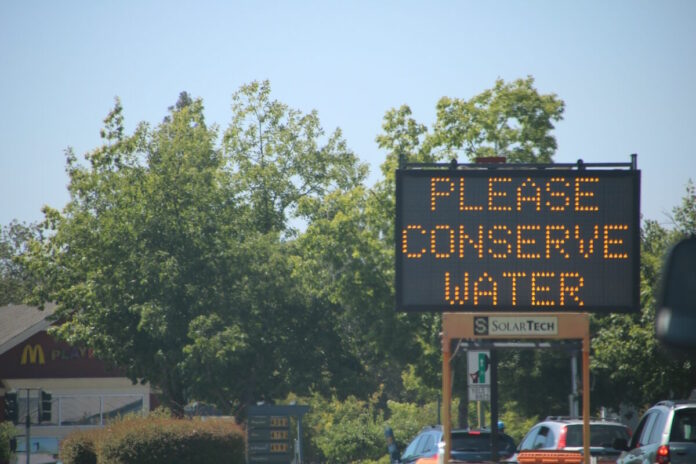As drought conditions tighten and reservoir levels drop, we thought it would be useful to know where our water comes from. In Windsor, the answer is found in the 2020 Urban Water Management Plan (UWMP), prepared by consultants Woodard & Curran.
The Windsor Water District operates Windsor’s water utilities and provides water primarily for residential and commercial use. According to the UWMP, the town’s total water demand in 2020 was 4,288 acre-feet per year (AFY), including residential, commercial and industrial water demand (2,975 AFY), landscape irrigation (540 AFY), recycled water demand for potable offset (504 AFY) and unaccounted-for water losses (269 AFY).
Windsor’s demand is “relatively constant” with increased use matching projected population growth. Water demands are projected to increase by about 1.6% per year based primarily on expected population and employment growth. The actual 2020 total gross per capita water use is 119 gallons per capita per day (gpcd).
About the wells and the river
Since 1984, Windsor’s water has come from two primary water sources: 85% of the town’s supply comes from the Russian River well field and the remaining 15% comes from a wholesale surface water purchased from Sonoma Water.
According to the UWMP, the Russian River well field pumps water shallow wells, roughly from 50 feet below ground, and adjacent to the Russian River. The water extracted is considered surface water in connection with underflow from the river and is extracted per the Sonoma County Water Agency (Sonoma Water) water right.
The wholesale water purchased from Sonoma Water is delivered to the town’s water distribution network via the Santa Rosa Aqueduct. Both water sources are reliant on the Russian River. Other sources of water supply include tertiary-treated recycled water from the local town wastewater treatment plant and applied to specific landscape and agricultural parcels and groundwater from the Esposti Well that provides raw water to irrigate Esposti Park.
Therefore, Windsor currently depends almost entirely on surface water supplies obtained directly or indirectly from the Russian River. The Russian River is rain-fed, depending on the timing and magnitude of precipitation events for its flows (unlike snow-fed rivers that rely on Sierra snow melt for seasonal flows). As such, flows in the Russian River, and subsequently the ability to divert those flows, may be affected in the future by climate change impacts on precipitation which are generally predicted to result in shorter periods of more intense flows in the future.
Where the water comes from
Sonoma Water is a partner in the management of two reservoirs on the Russian River for both flood control and water supply, Lake Mendocino and Lake Sonoma. According to the UWMP, Sonoma Water determines the amount of water to be released from each reservoir when the lake levels are in the water supply pools. The U.S. Army Corps of Engineers (USACE) determines the amount of water to be released when the lake levels are above the water supply pools and in the flood control pools.
Lake Mendocino relies on year-to-year rainfall as well as water diverted from the Potter Valley Project. Lake Mendocino is a key drinking water source for the cities of Ukiah, Healdsburg, Cloverdale and Hopland, and also provides water to Sonoma Water’s Russian River water supply system. Water releases from Lake Mendocino support flows in the Russian River for the threatened Chinook salmon and steelhead trout during the fall and winter seasons. Lake Sonoma is about four times larger than Lake Mendocino and provides multiple years of water supply.
Lake Sonoma relies on rainfall and supports a dynamic and fragile ecosystem in Dry Creek that includes the endangered Coho salmon and threatened steelhead trout. Lake Sonoma also provides a majority of Sonoma Water’s service area, including the Town of Windsor, with its drinking water. The Russian River is a managed river system with reservoir releases controlling river flows, especially throughout most of the summer and fall. When tributary stream flows are low, Sonoma Water releases water stored in the reservoirs to supplement the natural flows in the Russian River to provide adequate flows for water supply, recreation and aquatic habitat.
At the July 21 Windsor Town Council meeting, it was announced that the historical dry conditions have resulted in severely low storage levels in Lake Mendocino, prompting a Temporary Urgency Change Order (TUCO) which was issued by the State Water Resources Control Board on June 14, enabling lowering stream releases to the Russian River and preserving lake storage. The TUCO required the Sonoma County Water Agency and its water contractors, including the Town of Windsor, to reduce water diversions from the Russian River by 20%.
Other parts of the water system
Storage
There are 16 storage locations on seven sites that provide a combined 5.4 million gallons (MG) of storage capacity (16.6 AF). The largest portion (5.0 MG or 15.3 AF) serves the main pressure zone and includes the 1 MG and 2 MG Lakewood Hills tanks located in the north-eastern part of the Town and two 1 MG tanks at Shiloh Ridge. Three smaller pressure zones supply the Shiloh/Mayacama area. The Airport service area has no storage tanks.
Pump Stations
There are four booster pump stations. Three of these stations are located in and serve the Shiloh/Mayacama area. The fourth is located in the northeast portion of the Upper Vinecrest area within the town’s inside service area.
Distribution System Pipelines
Finally, there are nearly 120 miles of distribution piping of various diameters. The majority of these pipelines has been installed within the last 25 years and are in good condition.
Where it goes and who uses it
Windsor’s service area includes the town plus “outside service areas” that include the Airport and Shiloh/Mayacama service areas as well as a few other parcels. The Airport service area includes the Airport Specific Plan Area which is located around the Sonoma Marin Area Rail Transit station that is served by the Windsor Water District and identified by Sonoma County for redevelopment. These outside areas are serviced through outside service agreements.
The town itself encompasses approximately 6.7 square miles, while the outside service areas collectively cover approximately 5.8 square miles. Including the outside service areas, the town served approximately 28,397 people in 2020.
Windsor also provides non-potable water to customers for landscape irrigation and other needs. The recycled water system serves primarily golf courses and other landscaping needs. The town also produces raw water from the Esposti groundwater well which is delivered on site to Esposti Park.
In all, Windsor owns five off-river groundwater wells. These wells include the Esposti Park irrigation well, the Esposti Park potable well, Bluebird Well 1, Bluebird Well 2 and the Keiser Park irrigation well. Only one of the five wells, the Esposti irrigation well, is active; the remaining four off-river groundwater wells are inactive.
The Esposti irrigation well provides raw water for park irrigation and is not used as a potable source. According to the UWMP, the Esposti well is also currently under development as a potable water source. This well has not yet been permitted for municipal use but is currently being reviewed for potential activation with treatment.
As noted above, the two Bluebird wells and the Keiser Park well are inactive and not likely to be activated in the foreseeable future.









